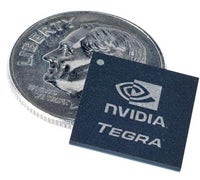 |
nVidia Tegra Source: Reuters |
On Sunday nVidia (NASDAQ: NVDA) announced a processor lineup it believes will power a new class of fast, small devices with long battery life that can surf the full Internet, play high-end games and display video in high definition.
The graphics chipmaker is calling the Tegra 600 and Tegra 650 processors “computers on a chip” for highly portable, visual devices, and it is aiming squarely at a market also targeted by No. 1 chipmaker Intel (NASDAQ: INTC).
nVidia hopes the Tegra chips, which also include its previously announced application processor APX2500 used in smartphones and handsets, will go into a broad array of computing devices. But it’s aiming first for an emerging category called mobile Internet devices, or MIDs.
Intel was among the first to start using the term, and its Atom family of chips is targeted at MIDs. But Intel and nVidia say people are still unsure exactly what a MID is.
nVidia says it is more than a dumbed-down notebook PC or superportable notebook with keyboards suited more for the hands of Smurfs than humans.
Mike Rayfield, general manager of nVidia’s mobile business, said MIDs have screens of four to 12 inches in diameter and may have a touch-screen or keyboard, a connection for a game controller or a wireless high-speed Internet connection.
“The systems now look more like dehydrated notebook computers,” Rayfield said.
But supercompact notebooks, smaller even than so-called ultra-mobile personal computers (UMPCs), have already taken off. The Asus Eee PC has been a runaway success, and Intel has said it would not be surprised to see sales of what it calls Netbook PCs such as the Eee PC and others top 50 million by 2011.
Tegra chips have as their main electronic brain an ARM 11 central processing unit core, a graphics processing unit, a media processor, system memory and peripherals in one ultra-low power-consuming chip smaller than a dime, Rayfield said.
Turf war
Rayfield said that while customers are lining up to use the chips in gizmos they are designing, they are not yet willing to disclose their plans. But at a major trade show this week called Computex, he said he would not be surprised to see Taiwanese gadget makers and others let slip a few details.
“By the end of the week, we’ll see people talking about the fact that they’re designing products around this technology,” Rayfield said. “All the initial products will come out of Taiwan; they’re the fastest to market.”
He said prices for MIDs with Tegra would range from $200 to $250 and be on store shelves by the holiday shopping season.
“If you’re looking for performance and good graphics capabilities and the ability of this thing to play HD video and the like, that’s pretty cool stuff,” said Insight 64 analyst Nathan Brookwood.
nVidia’s push with Tegra and Intel’s efforts with Atom foreshadow a battle between two types of chip architectures for dominance in the nascent tiny-but-powerful computing market.
The Atom chip family uses its x86 architecture, while ARM Holdings (NASDAQ: ARMH) processors have their own. Intel claims ARM chips grew up out of the communications and mobile phone markets, insisting its x86 architecture is better suited for computing applications such as gaming and Web browsing.
Not so, says nVidia’s Rayfield.
“ARM is coming from a position of having built the best performance-per-milliwatt devices for the last 10 years or more,” he said. “I’m very comfortable that it’s a battle being fought on their turf.”
Insight 64’s Brookwood said of the x86-versus-ARM battle: “It’ll be interesting to watch how it plays out.”


